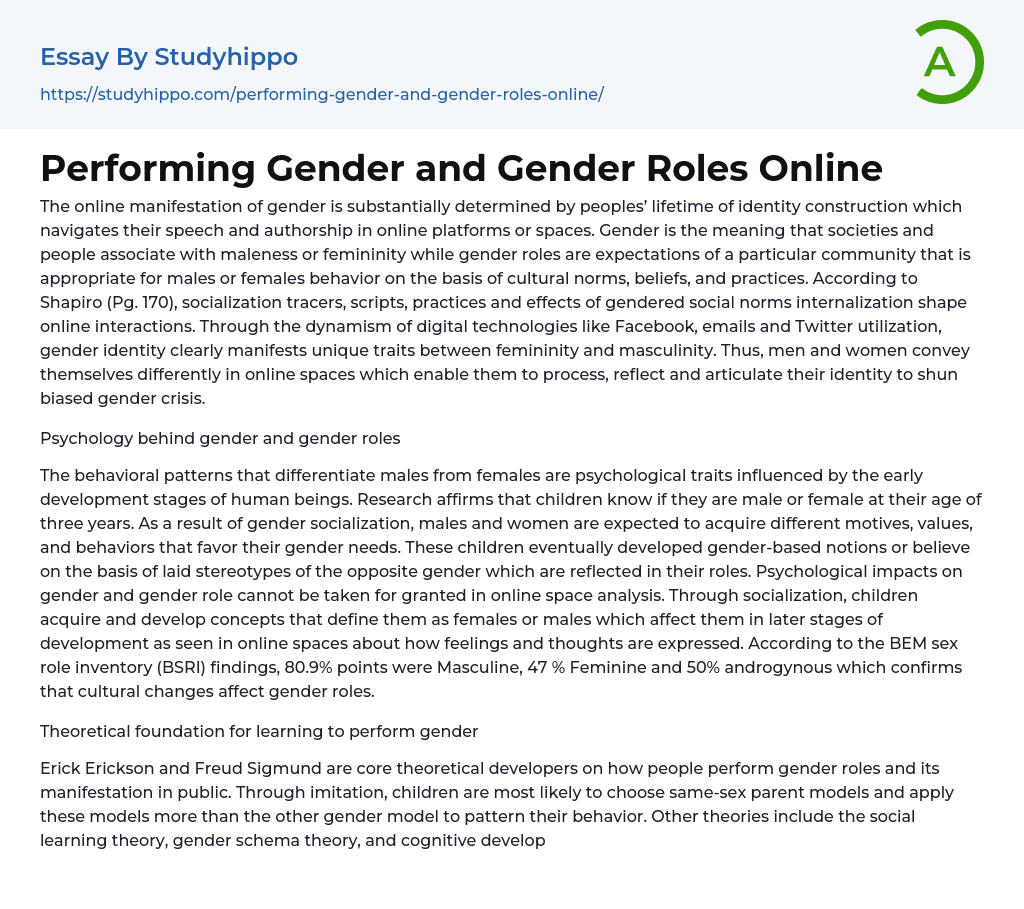The online manifestation of gender is substantially determined by peoples’ lifetime of identity construction which navigates their speech and authorship in online platforms or spaces. Gender is the meaning that societies and people associate with maleness or femininity while gender roles are expectations of a particular community that is appropriate for males or females behavior on the basis of cultural norms, beliefs, and practices. According to Shapiro (Pg. 170), socialization tracers, scripts, practices and effects of gendered social norms internalization shape online interactions. Through the dynamism of digital technologies like Facebook, emails and Twitter utilization, gender identity clearly manifests unique traits between femininity and masculinity. Thus, men and women convey themselves differently in online spaces which enable them to process, reflect and articulate their identity to shun biased gender crisis.
Psycholo
...
gy behind gender and gender roles
The behavioral patterns that differentiate males from females are psychological traits influenced by the early development stages of human beings. Research affirms that children know if they are male or female at their age of three years. As a result of gender socialization, males and women are expected to acquire different motives, values, and behaviors that favor their gender needs. These children eventually developed gender-based notions or believe on the basis of laid stereotypes of the opposite gender which are reflected in their roles. Psychological impacts on gender and gender role cannot be taken for granted in online space analysis. Through socialization, children acquire and develop concepts that define them as females or males which affect them in later stages of development as seen in online spaces about how feelings and thoughts are expressed. According to the BEM sex role inventory
View entire sample
Join StudyHippo to see entire essay
gy behind gender and gender roles
The behavioral patterns that differentiate males from females are psychological traits influenced by the early development stages of human beings. Research affirms that children know if they are male or female at their age of three years. As a result of gender socialization, males and women are expected to acquire different motives, values, and behaviors that favor their gender needs. These children eventually developed gender-based notions or believe on the basis of laid stereotypes of the opposite gender which are reflected in their roles. Psychological impacts on gender and gender role cannot be taken for granted in online space analysis. Through socialization, children acquire and develop concepts that define them as females or males which affect them in later stages of development as seen in online spaces about how feelings and thoughts are expressed. According to the BEM sex role inventory
(BSRI) findings, 80.9% points were Masculine, 47 % Feminine and 50% androgynous which confirms that cultural changes affect gender roles.
Theoretical foundation for learning to perform gender
Erick Erickson and Freud Sigmund are core theoretical developers on how people perform gender roles and its manifestation in public. Through imitation, children are most likely to choose same-sex parent models and apply these models more than the other gender model to pattern their behavior. Other theories include the social learning theory, gender schema theory, and cognitive development theory. The social learning theory stress of the power of observable behaviors and immediate situations in influencing people's performance. Children apply their gender role depending on how they are rewarded or punished. Secondly, discouragement and praise from the society to a boy who engages in boyish behaviors may discourage such boy from involving in feminine perceived activities. Girls who get reinforcement for their engagement on female concepts are also expected to shun masculinity.
The relationship between gender and language
Gender is a core element of social relations associated with perceived gender differences. Thus, gender traits are encoded in symbols and linguistic representation, social practices, normative concepts, social identification and social institutions. Linguistic stereotypes hold that men are likely to interrupt women during a speech that vice versa. Women communicate more than me. Men have minimal verbal recognition than women and that women gossip more than men. Other notions state that women speak more to each other than men yet men are more confident than females manifested in public spheres. All the factors contribute to how gender manifest in online spheres since language influences thoughts.
Gender speech patterns differences and attribution
Language patterns have a significant impact
in facilitating understanding among people in online spaces. Women patterns are more subtle, quiet and less aggressive as male patterns. Women who exhibit feminine speech patterns like the use of models, question tags, intensifiers are considered to be less confident, less believable and score low in their assertion levels which affect decision making and arguments in online platforms. Women are more conservative in their speech patterns than men, (Aikhenvald, 144). The gender pattern differences can be attributed to early socialization and cultural orientation which are carried by people throughout their development stages and exhibited in how they communicate online.
Online gender analyzer
The (Program #2: Gender Analyzer (V. 5)) online analyzer gave an 83% female score and a 17% male score to this Facebook post; “Hello, are you fine this morning? I hope you are”. It is thus clear that the question tag and concern in the statement manifest more femininity than masculinity. Certain, the algorithm was accurate since a woman composed the text to my inbox and the assumption reaches a valid conclusion about online gender representation.
Work cited
- Aikhenvald, Alexandra Y. How Gender Shapes the World. Corby: Oxford University Press, 2016. Print.
- Shapiro, Eve. Gender Circuits: Bodies and Identities in a Technological Age. New York: Routledge, 2010. Print.




